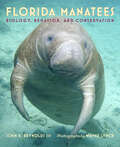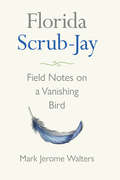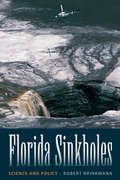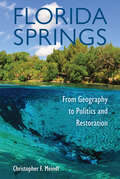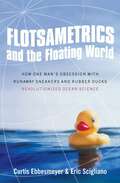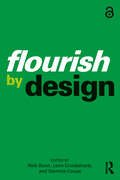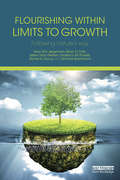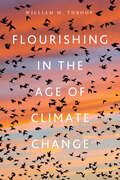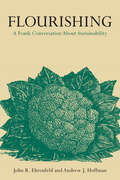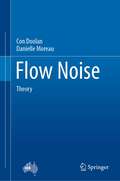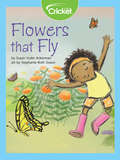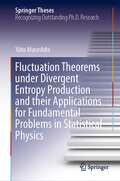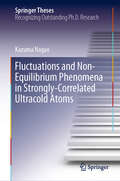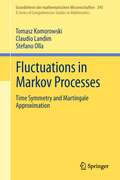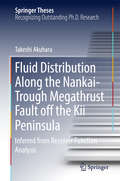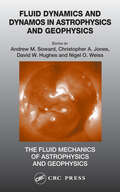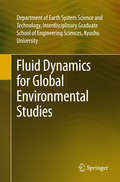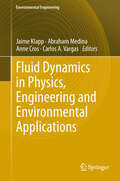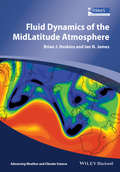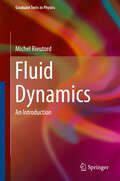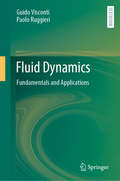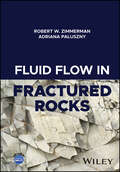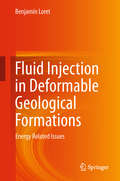- Table View
- List View
Florida Manatees: Biology, Behavior, and Conservation
by John E. Reynolds IIIA photographic journey into the secret world of Florida’s beloved manatee.Winner of the CHOICE Outstanding Academic Title of the Choice ACRLManatees, the gentle giants of Florida's lagoons and coastal habitats, can bring a smile to the face of anybody lucky enough to spy one. As manatees dip and roll through the water, crowds gather to watch them feed on aquatic vegetation. Whether they are congregating by the hundreds or resting or feeding alone, viewing these sea cows can provide anyone interested in nature with hours of tranquil pleasure.Having survived for eons, today's manatees are now under constant threat due to our rapidly swelling human population. Their habitats are often devastated by development and pollution. The slow-moving manatees also live at the mercy of chance, for they occupy waters filled with fast-moving boats powered by razor-sharp propellers—a new form of predator from which they have no protection. Boat speed limits have been put in place to protect manatees, but there is a constant push to lift them so that people can once again zip across the waters that manatees call home. For this reason, manatees are often a subject of controversy that pits their lives against the rights of boat owners. In this book, manatee expert John E. Reynolds III and famed photographer Wayne Lynch join forces to reveal the clearest portrait of manatees ever published. Florida Manatees is a song for the manatee, a celebration of the lives of these majestic creatures. Reynolds's concise, informative text shares what scientists know about manatees, while Lynch's beautiful photographs instantly demonstrate how special these "potatoes with whiskers" really are. By encouraging an appreciation of manatees, the authors hope to help ensure a future in which Floridians can find ways to coexist with and continue to enjoy these uniquely wonderful sirenian inhabitants of their state.Included in this book: How manatees first came to Florida waters How manatees fit into the ecosystems of Florida What and how much manatees eat How manatees behave and communicate with one another Why manatees look the way they do Why manatees have whiskers How manatee mothers feed their young and much more
Florida Manatees: Biology, Behavior, and Conservation
by John E. Reynolds IIIA photographic guide that “focuses on the beauty, grace and vulnerability of these herbivores, but it also covers other sea mammals and their habitats” (The Biologist).Named a Choice Outstanding Academic TitleIn this book, manatee expert John E. Reynolds III and famed photographer Wayne Lynch join forces to reveal the clearest portrait of manatees ever published. Florida Manatees is a song for the manatee, a celebration of the lives of these majestic creatures. Reynolds’s concise, informative text shares what scientists know about manatees, while Lynch’s beautiful photographs instantly demonstrate how special these “potatoes with whiskers” really are. By encouraging an appreciation of manatees, the authors hope to help ensure a future in which Floridians can find ways to coexist with and continue to enjoy these uniquely wonderful sirenian inhabitants of their state.Included in this book:How manatees first came to Florida watersHow manatees fit into the ecosystems of FloridaWhat and how much manatees eatHow manatees behave and communicate with one anotherWhy manatees look the way they doWhy manatees have whiskersHow manatee mothers feed their young and much more“A lovely book that sounds as though it would appeal primarily to scientists, but which offers inviting color photos and history that make it accessible to lay audiences both within Florida and outside the state.” —Donovan’s Literary Services
Florida Scrub-Jay: Field Notes on a Vanishing Bird
by Mark Jerome WaltersA portrait of a species on the brink The only bird species that lives exclusively in Florida, the Florida scrub-jay was once common across the peninsula. But as development over the last 100 years reduced the habitat on which the bird depends from 39 counties to three, the species became endangered. With a writer’s eye and an explorer’s spirit, Mark Walters travels the state to report on the natural history and current predicament of Florida’s flagship bird.Tracing the millions of years of evolution and migration that led to the development of songbirds and this unique species of jay, Walters describes the Florida bird’s long, graceful tail, its hues that blend from one to the next, and its notoriously friendly manner. He then focuses on the massive land-reclamation and canal-building projects of the twentieth century that ate away at the ancient oak scrub heartlands where the bird was abundant, reducing its population by 90 percent.Walters also investigates conservation efforts taking place today. On a series of field excursions, he introduces the people who are leading the charge to save the bird from extinction—those who gather for annual counts of the species in fragmented and overlooked areas of scrub; those who relocate populations of scrub-jays out of harm’s way; those who survey and purchase land to create wildlife refuges; and those who advocate for the prescribed fires that keep scrub ecosystems inhabitable for the species.A loving portrayal of a very special bird, Florida Scrub-Jay is also a thoughtful reflection on the ethical and emotional weight of protecting a species in an age of catastrophe. Now is the time to act, says Walters, or we will lose the scrub-jay forever.
Florida Sinkholes: Science and Policy
by Robert BrinkmannBelow the live oaks, palm trees, cypress swamps, and springs, water is slowly wearing away the limestone bedrock of Florida. The erosion is often unseen, and over time it can result in shocking cave-ins like the destructive spectacle of the 1981 Winter Park sinkhole.Florida Sinkholes--the first comprehensive book on the subject--is an easy-to-follow guide to understanding how sinkholes form and what to do about Florida's sometimes pockmarked landscape. City planners, construction managers, developers, and homeowners alike will find this book invaluable because of the heavy impact and increasing frequency of sinkhole formation in the state. Amateur geologists will be fascinated by the subtle forces of nature that can make solid rock disappear. Tackling the problem of sinkholes in useful detail, this book packs an abundance of sound scientific fact into frank, readable language. Learn about the captivating workings of karst, a term for the swiss cheese-like formations of soluble rock that underlie the peninsula. Discover current state-of-the-art approaches to mapping sinkholes and subsurface voids. Review such practical concerns as structural damage, repairs, insurance problems, and management of karst lands. Examine case studies of several notable sinkholes and sinkhole events. Even before you've finished reading, you may find yourself itching to get out and visit these intriguing marvels of Florida geology for yourself.
Florida Springs: From Geography to Politics and Restoration
by Christopher F. MeindlFlorida Book Awards, Gold Medal for Florida NonfictionAmerican Association of Geographers Globe Book Award for Public Understanding of GeographyAn indispensable resource for learning about the freshwater wonders of Florida Florida is home to over 1,000 freshwater springs, natural wonders that have drawn people to enjoy and interact with them over the course of millennia. This book provides a clear and comprehensive overview of the geography, history, science, and politics of the springs, informing readers about the deep past and current issues facing these treasures of the Florida landscape. Christopher Meindl explains the unique physical features of Florida’s springs, including the “swiss cheese” structure of the state’s aquifers and the complexities of its groundwater hydrology, providing helpful maps, graphs, and photos. Meindl discusses how ancient and modern people have used the springs—as centers of communities, therapeutic spas, roadside attractions, parks, and more. He addresses contemporary threats to the springs in areas such as water flow, water quality, and overcrowding. Finally, he explores recent state policies, the activism of environmentalists, and current and potential restoration projects that seek to prevent springs degradation. Meindl brings to light a struggle for truth among scientists, politicians, and businesspeople about the causes of problems the springs face today. Challenging oversimplified answers and looking at multiple hypotheses, Meindl raises intriguing questions that will inspire readers to join the ongoing discussion about how best to protect and restore Florida’s iconic freshwater sanctuaries.
Flotsametrics and the Floating World: How One Man's Obsession with Runaway Sneakers and Rubber Ducks Revolutionized Ocean Science
by Eric Scigliano Curtis Ebbesmeyer“Ebbesmeyer’s goal is noble and fresh: to show how the flow of ocean debris around the world reveals ‘the music’ of the world’s oceans.”—New York Times Book ReviewThrough the fascinating stories of flotsam, one of the Earth’s greatest secrets is revealed. In Flotsametrics and the Floating World, maverick scientist Curtis Ebbesmeyer details how his obsession with floating garbage—from rubber ducks to discarded Nike sneakers—helped to revolutionize ocean science. Scientist and environmentalist David Suzuki, host of CBC TV’s “The Nature of Things,” calls Flotsametrics and the Floating World “Science and storytelling at its very best.” “A very enjoyable, if at times dark, book” (Nature), it is must reading for anyone interested in Oceanography, Environmental Science, and the way our world works.
Flourish by Design
by Leon Cruickshank Nick Dunn Gemma CoupeFlourish by Design brings together a range of established and emerging voices in design research for a collection that provides original provocations on topics of global significance. It is an insightful guide to original theory and practice concerning how we can design for a better tomorrow. Featuring contributors from a diverse array of backgrounds and professions, this edited book explores the difference that design and design research can make for people, organisations, and the planet to prosper now and in the future. It offers a range of ideas and techniques through practical examples and ongoing projects showing how applied design research can respond to global challenges. Covering topics as diverse as artificial intelligence, bio-inspired materials, more-than-human design, sustainability, and urban acupuncture, it shares interdisciplinary and transdisciplinary design research not just to demonstrate what could be plausible in the near future but also to explain why it might be preferable. By sharing these despatches, this collection represents the very best of what design research can do, explaining how and why. This book is intended for a wide audience of professionals, scholars, and students in design, architecture, and public policy, as well as anyone who has an interest in how we design the world and, in turn, it designs us. The Open Access version of this book, available at www.taylorfrancis.com, has been made available under a Creative Commons Attribution-Non Commercial-No Derivatives (CC-BY-NC-ND) 4.0 license
Flourishing Within Limits to Growth: Following nature's way
by Sven Erik Jørgensen Brian D. Fath Søren Nors Nielsen Federico M. Pulselli Daniel A. Fiscus Simone BastianoniDecades of research and discussion have shown that the human population growth and our increased consumption of natural resources cannot continue – there are limits to growth. This volume demonstrates how we might modify and revise our economic systems using nature as a model. The book describes how nature uses three growth forms: biomass, information, and networks, resulting in improved overall ecosystem functioning and co-development. As biomass growth is limited by available resources, nature uses the two other growth forms to achieve higher resource use efficiency. Through a universal application of the three ‘R’s: reduce, reuse, and recycle, nature thus shows us a way forward towards better solutions. However, our current approach, dominated by short-term economic thinking, inhibits full utilization of the three ‘R’s and other successful approaches from nature. Building on ecological principles, the authors present a global model and futures scenario analyses which show that implementation of the proposed changes will lead to a win-win situation. In other words, we can learn from nature how to develop a society that can flourish within the limits to growth with better conditions for prosperity and well-being.
Flourishing in the Age of Climate Change
by William M. ThroopFlourishing in the Age of Climate Change explores skills we need to successfully navigate the distinctive environmental, social, and economic challenges of the twenty-first century. Our inability to address increasing resource constraints, social conflict, and ecological decline lead many toward a deep pessimism that saps motivation for change. Drawing on research from environmental science, ethics, psychology, sociology and educational theory, William M. Throop shows why cultivating underdeveloped skills involved in collaboration, humility, frugality and systems thinking can enable flourishing within our context. He also illustrates how we can strengthen such skills individually and how education can scale up their cultivation, which will be essential for achieving sustainability. Flourishing in the Age of Climate Change is a hopeful, practical resource for readers passionate about creating a world where we can thrive, and where flourishing is widespread.
Flourishing: A Frank Conversation About Sustainability
by Andrew J. Hoffman John R. EhrenfeldFlourishing: A Frank Conversation about Sustainability invites you into a conversation between a teacher, John R. Ehrenfeld, and his former student now professor, Andrew J. Hoffman, as they discuss how to create a sustainable world. Unlike virtually all other books about sustainability, this one goes beyond the typical stories that we tell ourselves about repairing the environmental damages of human progress. Through their dialogue and essays that open each section, the authors uncover two core facets of our culture that drive the unsustainable, unsatisfying, and unfair social and economic machines that dominate our lives. First, our collective model of the way the world works cannot cope with the inherent complexity of today's highly connected, high-speed reality. Second, our understanding of human behavior is rooted in this outdated model. Driven by the old guard, sustainability has become little more than a fashionable idea. As a result, both business and government are following the wrong path—at best applying temporary, less unsustainable solutions that will fail to leave future generations in better shape. To shift the pendulum, this book tells a new story, driven by being and caring, as opposed to having and needing, rooted in the beauty of complexity and arguing for the transformative cultural shift that we can make based on our collective wisdom and lived experiences. Then, the authors sketch out the road to a flourishing future, a change in our consumption and a new approach to understanding and acting. There is no middle ground; without a sea change at the most basic level, we will continue to head down a faulty path. Indeed, this book is a clarion call to action. Candid and insightful, it leaves readers with cautious hope.
Flow Noise: Theory
by Danielle Moreau Con DoolanThis book highlights the importance of sound produced by fluid flow or flow-induced noise. Noise created by unsteady flow creates high levels of environmental noise pollution, a known public health problem, and can compromise the acoustic qualities of marine vessels. There is a seemingly ever-growing list of modern technology that created flow-induced noise which includes aircraft, wind turbines, submarines, drones, high-speed rail, and cooling fans. More scientists and engineers are required to incorporate the effects of flow-induced noise in their work. This book also provides a comprehensive introduction to the theory underpinning the understanding of flow-induced noise.
Flow Through Heterogeneous Geologic Media
by Yeh, Tian-Chyi “Jim” and Khaleel, Raziuddin and Carroll, Kenneth C. Yeh, Tian-Chyi “Jim” Raziuddin Khaleel Kenneth C. CarrollThis textbook integrates classic principles of flow through porous media with recently developed stochastic analyses to provide new insight on subsurface hydrology. Importantly, each of the authors has extensive experience in both academia and the world of applied groundwater hydrology. The book not only presents theories but also emphasizes their underlying assumptions, limitations, and the potential pitfalls that may occur as a result of blind application of the theories as 'cookie-cutter' solutions. The book has been developed for advanced-level courses on groundwater fluid flow, hydraulics, and hydrogeology, in either civil and environmental engineering or geoscience departments. It is also a valuable reference text for researchers and professionals in civil and environmental engineering, geology, soil science, environmental science, and petroleum and mining engineering.
Flowers that Fly
by Susan Yoder AckermanSimon teaches his little cousin Adeline about how to grow a garden that will attract beautiful butterflies.
Fluctuation Theorems under Divergent Entropy Production and their Applications for Fundamental Problems in Statistical Physics (Springer Theses)
by Yûto MurashitaThis book presents the derivation of the fluctuation theorems with divergent entropy production and their application to fundamental problems in statistical physics. It explores the two basic aspects of the fluctuation theorems: i) Applicability in extreme situations with divergent entropy production, concluding that the fluctuation theorems remain valid under the notion of absolute irreversibility, and ii) utility in the investigation of classical enigmas in the framework of statistical physics, i.e., Gibbs and Loschmidt paradoxes. The book offers readers an overview of the research in fundamental statistical physics. Firstly it briefly but skillfully reviews the modern development of fluctuation theorems to found the key theme of the book. Secondly it concisely discusses historical issues of statistical physics in chronological order, along with the key literature in the field. They help readers easily follow the key developments in the fundamental research of statistical physics.
Fluctuations and Non-Equilibrium Phenomena in Strongly-Correlated Ultracold Atoms (Springer Theses)
by Kazuma NagaoThis book discusses non-equilibrium quantum many-body dynamics, recently explored in an analog quantum simulator of strongly correlated ultracold atoms. The first part presents a field-theoretical analysis of the experimental observability of the Higgs amplitude mode that emerges as a relativistic collective excitation near a quantum phase transition of superfluid Bose gases in an optical lattice potential. The author presents the dynamical susceptibilities to external driving of the microscopic parameters, taking into account a leading-order perturbative correction from quantum and thermal fluctuations and shows clear signatures of the Higgs mode in these observables. This is the first result that strongly supports the stability of the Higgs mode in three-dimensional optical lattices even in the presence of a spatially inhomogeneous confinement potential and paves the way for desktop observations of the Higgs mode. In the second part, the author applies the semi-classical truncated-Wigner approximation (TWA) to far-from-equilibrium quantum dynamics. Specifically, he considers the recent experiments on quantum-quench dynamics in a Bose-Hubbard quantum simulator. A direct comparison shows remarkable agreement between the numerical results from TWA and the experimental data. This result clearly indicates the potential of such a semi-classical approach in reliably simulating many-body systems using classical computers. The book also includes several chapters providing comprehensive reviews of the recent studies on cold-atomic quantum simulation and various theoretical methods, including the Schwinger-boson approach in strongly correlated systems and the phase-space semi-classical method for far-from-equilibrium quantum dynamics. These chapters are highly recommended to students and young researchers who are interested in semi-classical approaches in non-equilibrium quantum dynamics.
Fluctuations in Markov Processes
by Claudio Landim Stefano Olla Tomasz KomorowskiThe present volume contains the most advanced theories on the martingale approach to central limit theorems. Using the time symmetry properties of the Markov processes, the book develops the techniques that allow us to deal with infinite dimensional models that appear in statistical mechanics and engineering (interacting particle systems, homogenization in random environments, and diffusion in turbulent flows, to mention just a few applications). The first part contains a detailed exposition of the method, and can be used as a text for graduate courses. The second concerns application to exclusion processes, in which the duality methods are fully exploited. The third part is about the homogenization of diffusions in random fields, including passive tracers in turbulent flows (including the superdiffusive behavior). There are no other books in the mathematical literature that deal with this kind of approach to the problem of the central limit theorem. Hence, this volume meets the demand for a monograph on this powerful approach, now widely used in many areas of probability and mathematical physics. The book also covers the connections with and application to hydrodynamic limits and homogenization theory, so besides probability researchers it will also be of interest also to mathematical physicists and analysts.
Fluid Distribution Along the Nankai-Trough Megathrust Fault off the Kii Peninsula: Inferred From Receiver Function Analysis (Springer Theses)
by Takeshi AkuharaThis thesis explores fluid distribution along the Nankai-Trough megathrust fault around the Kii Peninsula of Japan, where devastating earthquakes are expected to occur in the near future. Exploring fluid distribution along subduction zones is an important issue because the fluid is considered to control the occurrence of earthquakes. One of the effective strategies to estimate fluid content is retrieving receiver functions (RFs) from seismograms, but in the case of ocean-bottom seismometers (OBSs), noisy P-wave reverberations within the seawater column make such an analysis difficult. The author therefore developed a novel technique to suppress the water reverberations, which allows obtaining the fluid distribution data along a wide depth range on the plate interface. This thesis first presents the new technique, called the water layer filter method, and demonstrates its efficiency by using both synthetic and observation data. Then, using the method, a receiver function image of the Philippine Sea Plate is constructed to reveal dehydration processes of the subducting oceanic crust around the Kii Peninsula. Finally, the author performs high-frequency receiver function inversion analysis. The results indicate the presence of a thin fluid-rich sediment layer along the megathrust fault off the Kii Peninsula that acts as a pathway of fluid. Nowadays, the number of offshore observations is increasing worldwide. In this respect, the attempt to better analyze OBS data employing the new method will become more important in future studies.
Fluid Dynamics and Dynamos in Astrophysics and Geophysics (The Fluid Mechanics of Astrophysics and Geophysics)
by Christopher A. Jones David W. Hughes Andrew M. Soward Nigel O. WeissThe increasing power of computer resources along with great improvements in observational data in recent years have led to some remarkable and rapid advances in astrophysical fluid dynamics. The subject spans three distinct but overlapping communities whose interests focus on (1) accretion discs and high-energy astrophysics; (2) solar, stellar, and
Fluid Dynamics for Global Environmental Studies
by Dept. Earth Sys Sci. Tech. Interdis.Grad Sch Engg Sci Kyushu Univ.This book introduces the basic concepts of environmental fluid dynamics. It is intended for use by students, researchers, engineers, and specialists working not only in general fluid research but also in the atmospheric and oceanic research fields. The Earth is covered by atmosphere and oceans and is exposed to solar wind. Therefore, the knowledge of fluid dynamics is essential for tackling its environmental issues. Although many textbooks have treated fluid dynamics, practically no book has been published that clearly describes all essential ideas, from the fundamentals of fluid dynamics to advanced environmental sciences, with careful sequential explanations of the governing mathematics. This book has been developed to solve these educational problems and has actually been in use in lectures in the graduate school of Kyushu University for more than 15 years.
Fluid Dynamics in Physics, Engineering and Environmental Applications
by Jaime Klapp Abraham Medina Anne Cros Carlos A. VargasThe book contains invited lectures and selected contributions presented at the Enzo Levi and XVII Annual Meeting of the Fluid Dynamic Division of the Mexican Physical Society in 2011. It is aimed to fourth year undergraduate and graduate students, and scientists in the field of physics, engineering and chemistry that have interest in Fluid Dynamics from the experimental and theoretical point of view. The invited lectures are introductory and avoid the use of complicate mathematics. The other selected contributions are also adequate to fourth year undergraduate and graduate students. The Fluid Dynamics applications include multiphase flow, convection, diffusion, heat transfer, rheology, granular material, viscous flow, porous media flow, geophysics and astrophysics. The material contained in the book includes recent advances in experimental and theoretical fluid dynamics and is adequate for both teaching and research.
Fluid Dynamics of the Mid-Latitude Atmosphere (Advancing Weather and Climate Science)
by Ian N. James Brian J. HoskinsThis book gives a coherent development of the current understanding of the fluid dynamics of the middle latitude atmosphere. It is primarily aimed at post-graduate and advanced undergraduate level students and does not assume any previous knowledge of fluid mechanics, meteorology or atmospheric science. The book will be an invaluable resource for any quantitative atmospheric scientist who wishes to increase their understanding of the subject. The importance of the rotation of the Earth and the stable stratification of its atmosphere, with their implications for the balance of larger-scale flows, is highlighted throughout.Clearly structured throughout, the first of three themes deals with the development of the basic equations for an atmosphere on a rotating, spherical planet and discusses scale analyses of these equations. The second theme explores the importance of rotation and introduces vorticity and potential vorticity, as well as turbulence. In the third theme, the concepts developed in the first two themes are used to give an understanding of balanced motion in real atmospheric phenomena. It starts with quasi-geostrophic theory and moves on to linear and nonlinear theories for mid-latitude weather systems and their fronts. The potential vorticity perspective on weather systems is highlighted with a discussion of the Rossby wave propagation and potential vorticity mixing covered in the final chapter.
Fluid Dynamics: An Introduction (Graduate Texts in Physics)
by Michel RieutordThis book is dedicated to readers who want to learn fluid dynamics from the beginning. It assumes a basic level of mathematics knowledge that would correspond to that of most second-year undergraduate physics students and examines fluid dynamics from a physicist’s perspective. As such, the examples used primarily come from our environment on Earth and, where possible, from astrophysics. The text is arranged in a progressive and educational format, aimed at leading readers from the simplest basics to more complex matters like turbulence and magnetohydrodynamics. Exercises at the end of each chapter help readers to test their understanding of the subject (solutions are provided at the end of the book), and a special chapter is devoted to introducing selected aspects of mathematics that beginners may not be familiar with, so as to make the book self-contained.
Fluid Dynamics: Fundamentals and Applications
by Guido Visconti Paolo RuggieriThis introductory book addresses a broad range of classical Fluid Dynamics topics, interesting applications, and related problems in everyday life. The geophysical and astrophysical applications discussed concern e.g. the shape and internal structure of the Earth and stars, the dynamics of the atmosphere and ocean, hydrodynamic instabilities, and the different kinds of waves that can be found in the atmosphere, ocean and solid Earth. Non-linear waves (solitons) are also mentioned. In turn, the book explores problems from everyday life, including the motion of golf balls, life at low Reynolds numbers, the physics of sailing, and the aerodynamics of airplanes and Grand Prix cars. No book on this topic would be complete without a look at chaos and turbulence; here the problems span from Gaussian plumes to chaotic dynamos, to stochastic climate modeling. Advances in fluid dynamics have produced a wealth of numerical methods and techniques, which are used in many of the applications. Given its structure, the book can be used both for an introductory course to fluid dynamics and as preparation for more advanced problems typical of graduate-level courses.
Fluid Flow in Fractured Rocks
by Robert W. Zimmerman Adriana PalusznyFLUID FLOW IN FRACTURED ROCKS "The definitive treatise on the subject for many years to come" (Prof. Ruben Juanes, MIT) Authoritative textbook that provides a comprehensive and up-to-date introduction to fluid flow in fractured rocks Fluid Flow in Fractured Rocks provides an authoritative introduction to the topic of fluid flow through single rock fractures and fractured rock masses. This book is intended for readers with interests in hydrogeology, hydrology, water resources, structural geology, reservoir engineering, underground waste disposal, or other fields that involve the flow of fluids through fractured rock masses. Classical and established models and data are presented and carefully explained, and recent computational methodologies and results are also covered. Each chapter includes numerous graphs, schematic diagrams and field photographs, an extensive reference list, and a set of problems, thus providing a comprehensive learning experience that is both mathematically rigorous and accessible. Written by two internationally recognized leaders in the field, Fluid Flow in Fractured Rocks includes information on: Nucleation and growth of fractures in rock, with a multiscale characterization of their geometric traits Effect of normal and shear stresses on the transmissivity of a rock fracture and mathematics of fluid flow through a single rock fracture Solute transport in rocks, with quantitative descriptions of advection, molecular diffusion, and dispersion Fluid Flow in Fractured Rocks is an essential resource for researchers and postgraduate students who are interested in the field of fluid flow through fractured rocks. The text is also highly suitable for professionals working in civil, environmental, and petroleum engineering.
Fluid Injection in Deformable Geological Formations: Energy Related Issues
by Benjamin LoretThis book offers an introduction to the geomechanical issues raised by both the extraction of actual and potential energy resources, and by the treatment of the ensuing environmental concerns. Discussions of the operations of injection of fluids into, and withdrawal from, geological formations link the chapters, each devoted to a particular technical aspect or scientific issue, or to a particular energy resource.Subjects are ordered according to their industrial applications, including enhanced oil and gas recovery, gas hydrates, enhanced geothermal systems, hydraulic fracturing, and carbon dioxide sequestration. An overview of the industrial, research and simulation aspects for each subject is provided. Fluid Injection in Deformable Geological Formations will be of interest to academic and industrial researchers in a wide variety of fields, including computational mechanics, civil engineering, geotechnical engineering and geomechanics, engineering seismology, petroleum engineering, reservoir engineering, and engineering geology.
